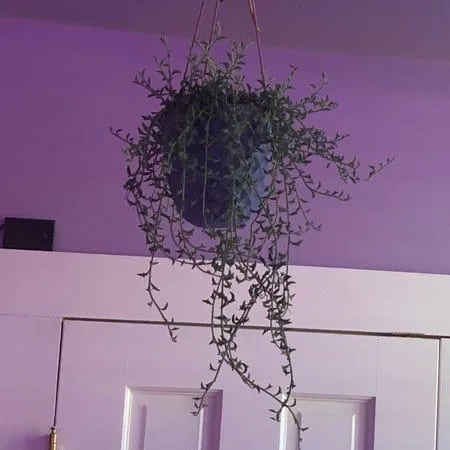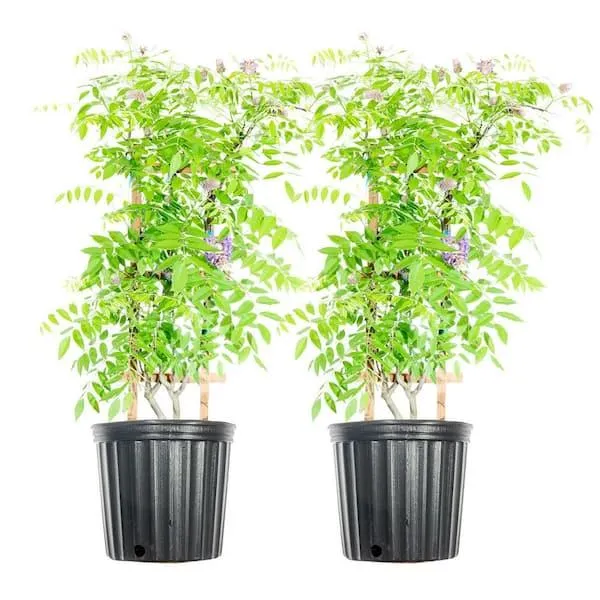All You Need to Know About Growing Purple Vine Houseplants
If you’re looking to add some beautiful purple foliage to your home, you’ve come to the right place. Purple vine houseplants are awesome choices that can brighten up any room with their vivid colored leaves. However, with so many options out there, it can be tough to know which variety is best for your needs. In this article, I’ll cover everything from popular purple vine plant varieties to care tips, so you can choose the perfect one. Let’s get started!
Popular Purple Vine Houseplant Varieties
Here are some top purple vine plants to consider for indoor growing:
- Purple Waffle Plant (Hemigraphis alternata) – Native to Southeast Asia, this plant features heart-shaped purple leaves with a waffle-like texture. It’s ideal for hanging baskets and thrives in medium to bright indirect light.
- Purple Queen Pothos (Epipremnum aureum) – A beautiful trailing plant perfect for desks or shelves. Its shiny oval leaves come in various shades of purple. Pothos are extremely low maintenance and tolerate low light.
- Polka Dot Plant (Hypoestes phyllostachya) – Unique round leaves spotted with pink and white splotches. Great for brightening up shady spots. Just be careful not to overwater this plant.
- Purple Passion Vine (Gynura aurantiaca) – Produces striking velvety deep purple oval leaves. A fast grower best for hanging baskets or taller pots. Requires consistent moisture and bright light.
Choosing the Right Purple Vine Plant
When selecting a purple vine houseplant, consider the following factors:
- Light Conditions – Different plants prefer varying light levels from low to bright indirect light. Match the plant to your window exposure.
- Space – Choose trailing or climbing varieties if you need a plant to cascade over a shelf or ledge. More compact choices work well on tables or desks.
- Care Needs – Some species like Pothos are very low maintenance while others may require more precise watering and feeding. Factor in your schedule.
- Aesthetic – Evaluate leaf shape, color, size, and texture to see what style fits your home’s vibe. Heart-shaped Polka Dot leaves have a different feel than long Waffle Plant leaves.
From my experience, Pothos, Waffle Plant, and Purple Passion are top choices for most homes. Read each plant tag carefully to suit your particular situation. A good nursery can also offer guidance to find your perfect match.

Caring for Purple Vine Houseplants
Once you’ve chosen your plant, follow these basic care tips to keep it thriving:
- Water – Feel the soil before watering. Water when the top inch is dry. Avoid soggy soil which can cause root rot.
- Feed – Use a diluted liquid houseplant fertilizer monthly during spring and summer. Less in winter when growth slows.
- Light – Position in a spot with your plant’s light needs. Rotate occasionally to prevent leaning. Stretching leaves signal low light.
- Pruning – Snip off any leggy or damaged growth to encourage bushier growth. Train climbers up poles or moss poles for support.
- Repotting – Only repot when roots fill the container. Do so in early spring using a well-draining soil mix.
Following those basics will keep your purple beauties happy and colorful for years. But there are always bound to be some hiccups—read on for solutions to common plant problems.
Issues and Solutions for Purple Vine Houseplants
Even with excellent care, plant pests and diseases may strike. Here are some typical issues you may face and how to deal with them:
- Wilting leaves – The poor guy could be thirsty! Check the soil and water thoroughly if dry. Overwatering causes similar symptoms, so wait until very dry between drinks.
- Yellowing leaves – This is usually a sign of nutrient deficiency. Try giving it a diluted liquid fertilizer per package directions.
- Brown crispy tips – Indicates your pH levels are off. Flush soil thoroughly with water and adjust with a fertilizer designed for alkaline or acidic-leaning soils.
- Spider mites – Tiny spider-like bugs suck out plant juices, leaving stippling. Wash leaves with water or treat with insecticidal soap. Isolate from other plants til clear.
- Mealybugs – Fluffy white pests hide in leaf joints. Wipe with alcohol or horticultural oil. Repeat treatment for a few weeks to totally eliminate this persistent pest.
By addressing any problems promptly and matching cultural requirements to your care regimen, you can avoid most issues down the road. A glass of wine and groovy tunes also help me relax and think positive when gardening indoors!

Propagating Purple Vines
If you find yourself with an impressive full plant, you might want to multiply it and share with plant pals. Many purple vine varieties readily root from stem cuttings, allowing you to expand your jungle for free:
- Prepare Cuttings – Snip 6-8 inch stems under a node (where leaves grow). Remove lower leaves leaving top 2-3 sets.
- Rooting Hormone – Dip cut end in rooting hormone powder to encourage new root growth.
- Potting Medium – Insert cuttings 1-2 inches deep in a soil-less potting mix like perlite or vermiculite. Dampen but don’t soak.
- Environment – Place pot in a warm spot out of direct sun and mist or cover with a plastic bag. Check for new roots in 2-4 weeks before transplanting.
Now you have more vines to decorate with or give as thoughtful planty gifts. Sharing homegrown specimens is truly the best feeling. Let me know if you need any other plant help!
Final Thoughts on Purple Vine Houseplants
Whether used as a hanging decoration or climbing a bookshelf, purple vine houseplants bring drama and style indoors. With just basic care tailored to species needs, these beauties will reward you with fantastic foliage for months or years. Don’t be afraid to experiment to see what thrives best in your space. And remember, part of the fun is trying new plants and seeing their surprising vibrant hues emerge. Good luck, and happy planting!
Purple Vine House Plant Care Tips
| Plant Type | Watering | Light | Soil | Pruning |
|---|---|---|---|---|
| Trailing Vine | Allow soil to dry between waterings, water when top inch of soil is dry | Bright indirect light | Well-draining potting mix | Cut off vines to control size or to promote bushier growth |
| Purple | Water less in winter when plant is not actively growing | Avoid direct sunlight which can scorch leaves | Do not allow plant to sit in water | Pinch back tips to promote fullness |
| Philodendron hederaceum | Mist leaves to increase humidity | Tolerates low light but will vine more in bright light | Propagate from stem cuttings | Fertilize monthly during growing season |
| Low maintenance | Allow soil surface to dry out between waterings | Thrives in eastern and southern windows | Prune any dead or diseased growth | Blooms white inconspicuous flowers |
FAQ
-
What colors does the purple vine come in?
The purple vine plant sort of only comes in one color – purple! Its leaves and vines are almost always deep purple. On rare occasions, you may find a variegated variety that has white splotches on the leaves too. But for the most part, if you see a vine called “purple vine,” its gonna be a purple fella.

-
How fast does it grow?
The purple vine can grow kinda fast under the right circumstances. If given lots of sunlight and kept moist, it may spread several feet in a single season. Nevertheless, its growth rate differs based on conditions. Perhaps keep it in a hanging basket at first until you see how ambitious it wants to be! The vines can get pretty lengthy after awhile if unrestricted.
-
What kind of light does it need?
This plant does best with bright, indirect sunlight. Too much direct rays could scorch the leaves. On the other hand, it won’t be too thrilled in low light spots either. Try a west or east window where it gets sun for part of the day. You may want to acclimate it to outdoor sun slowly in summer. But is that enough light to keep it healthy? Who knows – the needs can vary between different purple vine varieties.
-
How often should I water it?
As with lighting, watering frequency relies on conditions. When the soil becomes dry about 1/2 inch below the surface, it’s time to water thoroughly until draining from the bottom. Of course, this may happen every 5 days in summer compared to every 2 weeks in winter. The soil must never be soaked or sit in water though – that’s a sure way to get root rot. Always aim to keep the soil slightly moist but not overly damp. But who can really tell for sure what it wants? I’m no plant expert!
-
What kind of soil does it like?
Apparently the purple vine does best in well-draining potting mixes. Something lightweight with lots of components like perlite or bark will prevent overwatering issues. You definitely don’t want to use regular topsoil which can become too dense and soggy. Maybe try adding some compost to provide nutrients. Say, do you think miracil would work instead? I’m only guessing here since my green thumb is nothing amazing!

-
Is it toxic to pets or humans?
Fortunately the purple vine is considered non-toxic to both pets and people. Though I’m sure eating a bunch of leaves wouldn’t be good for your health. As long as it’s just displaying indoors and kept out of chewing distance, Fido should be safe from any severe reactions. Although I guess anything is possible, right? Who knows, perhaps old Fido once chowed down on a purple vine stem with no problems at all. Animals are weird like that sometimes!
-
What kinds of pests might it attract?
Mealybugs and spider mites seem to like purple vines, so keep an eye out for them. Overwatering or low humidity could make infestations worse. You may see tiny white or gray bugs crawling on the undersides of leaves or fine webbing between stems. A gentle spray of insecticidal soap may do the trick. However, prevention is key through good care instead of relying on pesticides. Hmm, I wonder if Neem oil would ward those creeps off too? Maybe someone out there can confirm – any plant pro readers have thoughts to share?
-
When should I repot it?
Most sources agree to repot the purple vine every couple years or when it becomes rootbound in the current container. Signs may include slowed growth, wilting, or spider mites. Usually spring is an ideal time as it settles into its new home before growth spurt. You can go up just 1-2 inches in pot size. Although who’s to say it won’t be content forever in the same pot if conditions remain suitable? I’m no expert after all!
